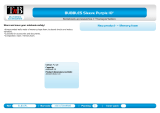
10 Using Setup Utility (BIOS) and System Diagnostics – Ubuntu ......................................................................... 79
Starting Setup Utility ........................................................................................................................................... 79
Using Setup Utility ............................................................................................................................................... 79
Changing the language of Setup Utility ............................................................................................ 79
Navigating and selecting in Setup Utility .......................................................................................... 79
Displaying system information ......................................................................................................... 80
Restoring factory default settings in Setup Utility .......................................................................... 80
Exiting Setup Utility ........................................................................................................................... 80
Using HP PC Hardware Diagnostics (UEFI) .......................................................................................................... 80
Downloading HP PC Hardware Diagnostics (UEFI) to a USB device .................................................. 81
11 Specifications ........................................................................................................................................... 82
Computer specifications ...................................................................................................................................... 82
12 Backing up, restoring, and recovering – Windows 10 ..................................................................................... 83
Creating recovery media and backups ................................................................................................................ 83
Creating HP Recovery media (select products only) ........................................................................ 84
Using Windows Tools ........................................................................................................................................... 85
Restore and recovery .......................................................................................................................................... 85
Recovering using HP Recovery Manager .......................................................................................... 86
What you need to know before you get started ............................................................ 86
Using the HP Recovery partition (select products only) ................................................ 87
Using HP Recovery media to recover ............................................................................. 87
Changing the computer boot order ................................................................................ 88
Removing the HP Recovery partition (select products only) ......................................... 88
13 Backing up, restoring, and recovery – Windows 8.1 ...................................................................................... 89
Creating recovery media and backups ................................................................................................................ 89
Creating HP Recovery media (select models only) ........................................................................... 89
Using Windows tools ........................................................................................................................................... 90
Restore and recovery .......................................................................................................................................... 90
Recovering using HP Recovery Manager .......................................................................................... 91
What you need to know before you get started ............................................................ 91
Using the HP Recovery partition (select models only) .................................................. 92
Using HP Recovery media to recover ............................................................................. 92
Changing the computer boot order ................................................................................ 92
Removing the HP Recovery partition (select models only) ........................................... 93
14 Backing up, restoring, and recovering – Ubuntu ........................................................................................... 94
Performing a system recovery ............................................................................................................................ 94
ix






















